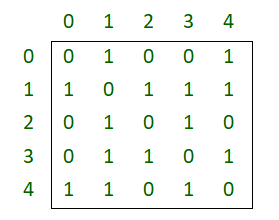

While basic operations are easy, operations like inEdges and outEdges are expensive when using the adjacency matrix representation.Īdjacency Matrix Code in Python, Java, and C/C++.Graphs out in the wild usually don't have too many connections and this is the major reason why adjacency lists are the better choice for most tasks. The VxV space requirement of the adjacency matrix makes it a memory hog.By performing operations on the adjacent matrix, we can get important insights into the nature of the graph and the relationship between its vertices.The recent advances in hardware enable us to perform even expensive matrix operations on the GPU. The biggest advantage, however, comes from the use of matrices.Even if the graph and the adjacency matrix is sparse, we can represent it using data structures for sparse matrices. If the graph is dense and the number of edges is large, an adjacency matrix should be the first choice.The basic operations like adding an edge, removing an edge, and checking whether there is an edge from vertex i to vertex j are extremely time efficient, constant time operations.In case of undirected graphs, the matrix is symmetric about the diagonal because of every edge (i,j), there is also an edge (j,i). For instance, there is a path from vertex 1 to vertex 2, so A 12 is 1 and there is no path from vertex 1 to 3, so A 13 is 0. If there is a path from i to j, then the value of A ij is 1 otherwise its 0. Decrease Key and Delete Node Operations on a Fibonacci Heap.This is available in Centrality measures and called 'Weights of connected Edges'. This is done with the layout algorithms from the menu.ĥ. You can change the shape of any node at any time, too. The node shape used by the import is the one that is selected (by double-clicking) in the Palette window. The import feature does this, too, depending on the 'Layout' setting in the 'Presentation' tab of the dialog.ģ. After changing the node size, you should run one of the layout algorithm that fits your needs from the menu. Alternatively, the range A2:F6 and checking only the option 'Node IDs in First Row' should work, too.Ģ. If there are two nodes of the name Anna, there might be a subtitle difference, for example an additional space character. For the data range A1:F6 you should check both options 'Node IDs in First Row' and 'Node IDs in First Column' since, obviously, both the first row and the first column contain the names. In a network, for example the friendship network, is it possible to do statistical test showing which node has the largest incoming edges (arrows point to the node) ? The overall connection strength among selected nodes?ġ. In the demo video, I saw layout the the network structure can be adjusted from one shape to another (cool!!!), but I did not find how I can do that ? Is it a way that edges (line connecting two nodes) can be longer so that nodes won't overlap ?īy default, nodes are plotted in rectangular or ellipse, may I adjust the shape ? Your way to describe the size of node is awesome! But sometimes those nodes become too big, they overlap and I cannot even see those edges. Could you please suggest a way to tell yEd that there are only 5 nodes, from "Anna" to "Elena" The final plot includes a separate node "Anna". I selected A1:F6, yEd detects 6 nodes, instead of 5. Thank you michael, your methods are mostly working, except that yEd treats A1 as a node. Please suggest where I did wrong? How can I put names into Node box?Īnd is there a way to change the size of the node box as a function of connection numbers? say, if there are 5 people connecting with Anna, so Anna box will become larger?

But what I got is a social map in the same shape as the example, but in each node only the label index visible, say 1,2,3,4,5, but not Anna, Ben, Chris. I want to put names into grids, just like what shown in the example figure. In "Presentation", under Nodes, I select "Node Label" for "Label Text". Strange thing is that if I tick "Node IDs in First ", the information line only dectcts 2 nodes? so I did not tick all those boxes, the program detects "5 Nodes, 8 Edges, 1 Node Property". From left to right is A to F, up to down is 1 to 6. In the section: import from excel, the example given:Ībove is the table I created in excel, then imported into yEd. I'm trying to reproduce figures in the hep document.


 0 kommentar(er)
0 kommentar(er)
